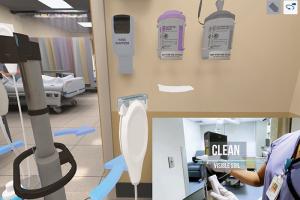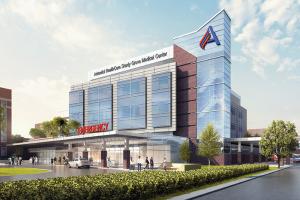Hospital wayfinding bridges digital divide
Digital signage has evolved into digital wayfinding as new systems branch out into various platforms such as kiosks, wall displays and smartphones. These technology-driven tools are being added to most hospitals as a complement to existing wayfinding solutions like landmarks, color-coding and static signs.
“Digital wayfinding is gaining a lot of traction due to the numerous pain points it addresses. For one, the navigational assistance provided is comprehensive. A network of digital directories informs; interactive kiosks orient and guide; and check-in kiosks enable visitors to access appointment and billing information,” says Preeti Dhindsa, marketing manager, Mvix (USA) Inc., Sterling, Va.
You may also like |
| Technological advantages in digital signage |
| Wayfinding elements in the environment of care |
| How hospitals have solved wayfinding challenges |
|
|
“The technology also helps to personalize experiences. Visitors can chart their course from an interactive kiosk and download the map to their phone through the use of a QR code. Some kiosks have talking avatars that facilitate comprehension. The avatars give additional information such as walk times and allow users to print directions,” Dhindsa adds.
In addition, most of the systems can be managed remotely from any internet-enabled device, allowing for quick updates.
On the move
As for market penetration, digital wayfinding is making inroads in health care but still has a way to go. “Digital signage is becoming ubiquitous in health care. One of the key aspects is wayfinding, and while the technology is advancing quickly, it is not yet mature,” says Michael Herweyer, vice president of technical sales, 2/90 Sign Systems, Grand Rapids, Mich. “The use of beacons or a similar technology to provide ‘indoor GPS’ directions, such as Google maps, exists but is rarely implemented, primarily due to cost.”
The most mature and widely deployed digital wayfinding technology is web-based tools, according to Leslie Wolke, a consultant and founder, MapWell Studio, Austin, Texas. These websites allow patients to plan their visits ahead of time. They can use their smartphones to access the wayfinding website to get guidance along their journey.
“Apps and on-site touchscreens are tied for second in the health care market, since each has its own unique advantages. Like all markets, health care is in a frenzy to develop the killer app. However, wayfinding isn’t the most pressing need for patients and single-use wayfinding apps are hard to justify. Touchscreens can provide on-the-spot navigational help, but require infrastructure and maintenance plans that are often outside standard operations,” Wolke says.
Medium to large hospitals and medical centers have been the early adopters of these systems, but that is changing dramatically as organizations of all types and sizes recognize the efficiencies and benefits that visual wayfinding solutions provide, says Angel Newsom, director of sales, health care, Four Winds Interactive, Denver. “We are seeing smaller facilities, clinics and medical office buildings implement this technology to change what patients and visitors experience when they walk in the door,” she says.
Accessing digital wayfinding systems from smartphones is a growing application, experts agree. “This is definitely the future of wayfinding and visual communications, as everyone has their own personal screen in their pocket,” Newsom says. “We see a growing need to personalize the experience of the patient or visitor and enable that connection to the health care organization they are visiting or [at which they are] being seen for treatment.”
Four Winds Interactive is already integrating smartphone capabilities, enabling information to be sent via text or QR code — as well as providing a true mobile application that can be downloaded by patients, families, employees and others to take information with them.
This alignment of using all form factors — whether that is a small mobile device or an interactive kiosk in a lobby — enables a well-balanced visual communications network, which makes it possible for organizations to leverage their investments while meeting the goals and objectives for a better patient experience.
Madeline Hennessy, director of sales, concept3D Inc., Boulder, Colo., agrees that mobile-friendly wayfinding is a growing trend. “In our own data — comparing the first six months of 2016 to that of 2015 — we’ve seen a 10 percent increase in mobile traffic to our clients’ interactive maps. That’s a big jump and it’s only going to continue. Still, desktop represents more than 50 percent of our clients’ overall traffic.”
The company’s data also show that many people still want hard copy maps. They are using concept3D’s atlas3D interactive map and media platform to select specific buildings or directions so they can print out exactly what they need to get around a facility.
DT Research, San Jose, Calif., works with systems integrators, such as Hilton Displays, to provide digital directories and interactive wayfinding solutions to hospitals. DT Research manufactures media players and content management software that integrators utilize to build a complete solution. Andy Fischer, manager, digital signage, says that smartphone use is a growing application on which the company has capitalized. “Our back-end WebDT Content Manager software is web-based and can be accessed from a smartphone or tablet. Also, users can retrieve up-to-date directory and wayfinding content from their mobile devices using QR codes and beacon technologies,” he explains.
Connecting platforms
Most vendors offer wayfinding systems on mobile, web and kiosk platforms to accommodate the differing needs of all sectors of the health care population. For example, systems provided by DT Research operate independently or in conjunction with kiosks.
Connexient Inc., New York City, offers the MediNav solution, which provides all-screens digital wayfinding — spanning web and mobile websites and integration into digital signage and kiosk platforms — and indoor navigation on mobile phones. An all-screens approach is critical to solution success, according to Geoff Halstead, chief product officer.
“Hospital patients and visitors represent a wide range of demographics and need information in different contexts. Connexient is focused on ensuring that users can get digital wayfinding information anytime and anywhere, including both web and mobile web for preplanning, but also on kiosks and digital signage when they arrive,” he says.
Hospitals can deploy either stand-alone kiosks provided by Connexient that are dedicated to digital wayfinding, or integrate MediNav maps into any existing HTML5-compliant kiosk or digital signage platform.
Among many wayfinding innovations introduced to the health care market, Mvix has developed more content widgets for its video wall solution. They enable facilities professionals to surround the hospital’s wayfinding map with content like news updates, emergency alerts, and charts and graphs to show visitor peak times. Mixing this information with the wayfinding map makes the video wall a hub where visitors can collect information for their visits.
LogicJunction Inc., Cleveland, in partnership with Indoor Atlas, has developed a line of mobile apps and software development kits that utilize a patented geomagnetic technology to pinpoint a user’s location indoors. The technology uses the aberrations in the Earth’s magnetic field that are caused by the steel structures of buildings to identify a user’s position on a map within 6 feet. The key advantage over alternative methods (such as beacons) is that minimal or no infrastructure is required, which reduces cost and implementation time, according to Mike Drozda, chief operating officer.
2/90 Sign Systems offers a universal touch-screen application called Vizia Interactive for health care facilities. Included is a web app that allows users to take its maps and other information with them when they leave the interactive kiosk. “The next challenge for our industry is to find a cost-effective way to provide a better experience from that point on,” Herweyer says. “The technology is there, but it is still somewhat expensive. It is evolving rapidly, though, as companies like ours push forward to improve the experience.”
Integration with all communication platforms is one key to success in the implementation of wayfinding systems, says Randy Cooper SEGD, DSCE, president, Cooper Signage & Graphics, Loganville, Ga. The company offers the Squire digital signage system, which is scalable to meet the needs of a variety of hospitals. It offers multiple levels of integration with communicative tools that include wayfinding apps for handheld devices as well as kiosks. Self-navigational capabilities offer options ranging from home to interior destination, with turn-by-turn graphics as well as text.
“Terminology, maps and even preferred pathways are often provided by different sources in hospitals. To effectively communicate directions, these tools must incorporate user-friendly text and graphics,” Cooper notes. For example, a doctor’s office might send a patient “to the hospital for a stress test,” which is not always listed as a destination on directories and signs. Instead, the patient should be instructed to “go to the outpatient services check-in at the hospital and tell them you were sent for a stress test.”
Hospital staff must be trained to provide consistent and current directions, Cooper adds. Continuity is critical across all forms of communication: verbal, printed, digital signage and traditional static sign systems.
Getting personal
Data collection from these devices allows facilities professionals to assess utilization levels, evaluate the effectiveness of various platforms, determine optimal placement of kiosks and study the flow of traffic within the institution, experts say.
One of the key features associated with digital signage solutions is data collection and management, Fischer agrees. “Interactive kiosks that include magnetic stripe readers and bar-code scanners provide an additional point of integration that can deliver personalized content and applications such as appointment scheduling, self-service pharmacy check-ins and patient-to-doctor communications.”
Connexient provides location-based tracking, reporting and analytics to give hospitals real-time visibility into the location and status of patients, visitors, vendors and staff, coupled with visual analytics on historic patient, visitor and staff workflows. “In particular, the following information on patient experience has high value: waiting times at different department reception rooms, and transit times for different patient journeys to book appointments,” Halstead notes.
Looking ahead, Hennessy expects to see more third-party integrations and technologies bundled together. “At concept3D, we collaborate with other companies to integrate data feeds. For example, a parking lot data feed allows visitors as well as managers to see the number of parking spaces available,” she says.
Personalization also will become increasingly important in all aspects of information delivery, especially in the health care arena, says Drozda. “At LogicJunction, we personalize the experience through targeted information delivery and the use of avatars or video greeters to welcome users in their own language. Expect to see more of this type of interface.”
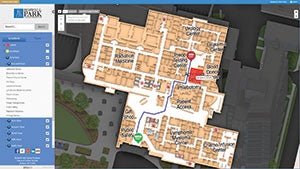
From A to B
The atlas3D wayfinding tool uses a mobile-friendly 3-D map to provide point-to-point directions between multiple floors and across facilities and medical campuses. concept3D Inc. www.concept3d.com
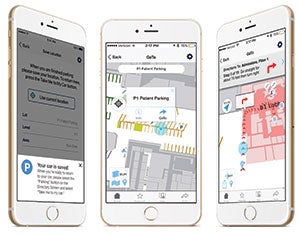
Smooth ride
The MediNav Parking Planner and My Car Saver features solve the complex challenges of parking at a large medical center. Connexient Inc.www.connexient.com
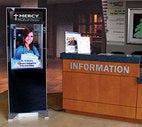
Sizing up
The Squire digital signage system is scalable to meet the needs of a variety of hospitals. Cooper Signage & Graphics www.signsystems.com

Digital insight
This wayfinding system at Peter Munk Cardiac Centre, Toronto (Ontario) General Hospital, directs visitors, gives details on services and illustrates health information. DT Research www.dtresearch.com

End-to-end
This information hub is part of a facilitywide implementation of interactive digital screens that greet patients upon arrival and guide them through their visit. Four Winds Interactive www.fourwindsinteractive.com

Pinpoint information
Using geomagnetic positioning, the visitor’s location is represented as a blue dot, and landmark pop-ups enhance both the experience and spatial orientation. LogicJunction Inc. http://logicjunction.com/
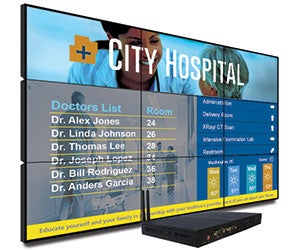
Writing on the wall
This video wall solution enables facilities managers to surround the hospital’s wayfinding map with dynamic content such as emergency alerts, live traffic and social media. Mvix (USA) Inc. http://mvixdigitalsignage.com/

Trusty guide
Wayfinding directories guide people in, through and out of the health care facility. 2/90 Sign Systems www.290signs.com


